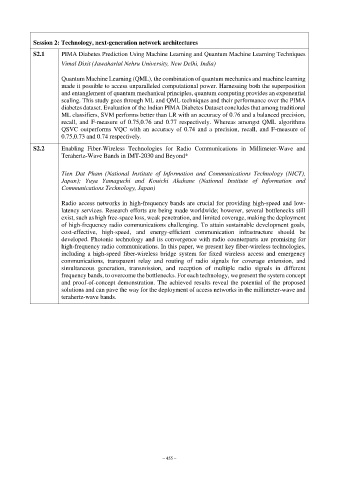Page 499 - Kaleidoscope Academic Conference Proceedings 2024
P. 499
Session 2: Technology, next-generation network architectures
S2.1 PIMA Diabetes Prediction Using Machine Learning and Quantum Machine Learning Techniques
Vimal Dixit (Jawaharlal Nehru University, New Delhi, India)
Quantum Machine Learning (QML), the combination of quantum mechanics and machine learning
made it possible to access unparalleled computational power. Harnessing both the superposition
and entanglement of quantum mechanical principles, quantum computing provides an exponential
scaling. This study goes through ML and QML techniques and their performance over the PIMA
diabetes dataset. Evaluation of the Indian PIMA Diabetes Dataset concludes that among traditional
ML classifiers, SVM performs better than LR with an accuracy of 0.76 and a balanced precision,
recall, and F-measure of 0.75,0.76 and 0.77 respectively. Whereas amongst QML algorithms
QSVC outperforms VQC with an accuracy of 0.74 and a precision, recall, and F-measure of
0.75,0.73 and 0.74 respectively.
S2.2 Enabling Fiber-Wireless Technologies for Radio Communications in Millimeter-Wave and
Terahertz-Wave Bands in IMT-2030 and Beyond*
Tien Dat Pham (National Institute of Information and Communications Technology (NICT),
Japan); Yuya Yamaguchi and Kouichi Akahane (National Institute of Information and
Communications Technology, Japan)
Radio access networks in high-frequency bands are crucial for providing high-speed and low-
latency services. Research efforts are being made worldwide; however, several bottlenecks still
exist, such as high free-space loss, weak penetration, and limited coverage, making the deployment
of high-frequency radio communications challenging. To attain sustainable development goals,
cost-effective, high-speed, and energy-efficient communication infrastructure should be
developed. Photonic technology and its convergence with radio counterparts are promising for
high-frequency radio communications. In this paper, we present key fiber-wireless technologies,
including a high-speed fiber-wireless bridge system for fixed wireless access and emergency
communications, transparent relay and routing of radio signals for coverage extension, and
simultaneous generation, transmission, and reception of multiple radio signals in different
frequency bands, to overcome the bottlenecks. For each technology, we present the system concept
and proof-of-concept demonstration. The achieved results reveal the potential of the proposed
solutions and can pave the way for the deployment of access networks in the millimeter-wave and
terahertz-wave bands.
– 455 –

